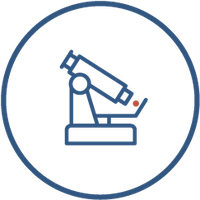Published: 22 October 2025
Artificial intelligence (AI) is rewriting the rules of drug discovery – accelerating timelines, reducing costs and providing new tools for drug hunters. The In Silico Discovery group at BioAscent has engaged in several collaborative projects with academic colleagues and students this year. These partnerships have proven mutually beneficial – enhancing BioAscent’s capabilities in AI and machine learning, while providing students with valuable industry experience and mentorship. In this blog, we speak to some of our students and collaborators about their work and experience at BioAscent.
AI-driven design of novel GLP-1R PAMs
Joan Clark-Nicolas, a postdoctoral research associate from the University of Lincoln, collaborated with BioAscent to leverage AI and machine learning to identify novel positive allosteric modulators (PAMs) for the GLP-1 receptor.
As anyone currently working in drug discovery knows, GLP-1 is a hot target, with peptide-based GLP-1 receptor agonists such as Ozempic becoming not just blockbuster drugs but also household names. Joan’s project aimed to utilise AI to identify small molecule GLP-1 receptor modulators which have the potential to address the challenge of poor oral bioavailability currently posed by peptide-based therapies.
Working alongside Dr Angelo Pugliese, Joan utilised REINVENT4, a deep generative reinforcement learning framework developed by researchers at AstraZeneca, to create an AI-driven workflow. The workflow integrated molecular dynamics simulations, large language model–based compound generation, docking, and active learning to generate a set of novel structurally diverse GLP-1 receptor PAMs with varied binding modes.
For Joan, the project offered the opportunity to learn more deeply about applying machine learning to a drug discovery scenario, and he was pleased that his poster on this work generated a lot of enthusiasm when presented at the Artificial Intelligence in Chemistry Symposium in Cambridge in September. He plans to further refine his model and hopes that the most promising ligands can eventually be synthesised and tested.
Reflecting on the collaboration, Joan highlighted the benefits to both parties: “It was really rewarding to bring researchers from industry and academia together. Working with people from different backgrounds and learning from one another can help to achieve a shared goal.”
Transferring knowledge between academia and industry
Ryan Zhu, a final-year PhD student at the University of Edinburgh, joined BioAscent for a 12-week placement this summer. The opportunity arose following a visit to our site, where his PhD supervisor, Dr Antonia Mey, had been invited to give a presentation. Carrying out research in computational biophysics, Ryan had become interested in how he could apply this to solve real-world problems and jumped at the chance to employ the knowledge gained during his PhD in a drug discovery environment.
Ryan worked with the In Silico Discovery team at BioAscent to generate novel small molecule structures targeting the NLRP3 inflammasome. The starting point for the project was a known pyridazine chemotype, which binds to the active site. Using REINVENT4, Ryan was able to generate novel ligands with alternative binding modes. These were then filtered to identify several promising molecules.
This placement opened up new opportunities for Ryan to engage with the drug discovery community – he also attended the Artificial Intelligence in Chemistry Symposium, where he presented a poster on his work.
This experience has strengthened Ryan’s resolve to work in drug discovery following his PhD: “I enjoyed the problem-orientated ways of working in industry. There are many different aspects to consider in the context of a drug discovery pipeline, and I appreciated the multi-disciplinary nature of the work. I’m looking forward to building on the skills I learned at BioAscent in the future.”
Applying AI to overcome real-world challenges in the lab
Donaldson Chuks Okolo, currently studying for an MSc in Big Data at the University of Stirling, joined BioAscent earlier this year for a summer internship in the In Silico Discovery group. Under the mentorship of Dr Angelo Pugliese, Donaldson tackled a common challenge in drug discovery: pan-assay interference compounds (PAINS).
PAINS interfere with biological screening assays, resulting in false positives that can cause misleading results. Donaldson’s project applied advanced data science to build and train predictive machine learning models capable of estimating how various buffer constituents, such as NP-40, DTT, and EGTA can affect assay performance. Using Bayesian optimisation, he created a framework to identify the optimal buffer conditions required to minimise assay interference for an enzymatic target. Donaldson’s model is currently undergoing validation, after which he hopes it will be used by scientists at BioAscent to save time and resources when undertaking High Throughput Screening (HTS) campaigns.
Donaldson spoke highly of the mentorship and collaborative spirit at BioAscent: “Angelo was a constant support throughout, and always available to help with any questions. An initial challenge for me was to understand the biology underlying the project, but I received lots of encouragement and support from George and Stuart in the biosciences team with this. I really enjoyed the team environment at BioAscent and sense of collaboration. It was great seeing my code work and make a difference for the scientists in the lab.”
Find out more about BioAscent's computational chemistry expertise here.




